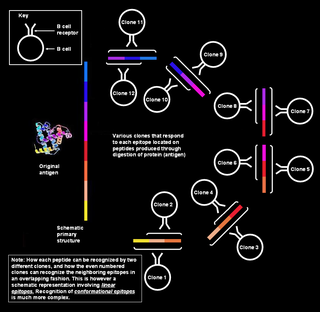
Snakes are elongated, legless, carnivorous reptiles of the suborder Serpentes. Like all other squamates, snakes are ectothermic, amniote vertebrates covered in overlapping scales. Many species of snakes have skulls with several more joints than their lizard ancestors, enabling them to swallow prey much larger than their heads with their highly mobile jaws. To accommodate their narrow bodies, snakes' paired organs appear one in front of the other instead of side by side, and most have only one functional lung. Some species retain a pelvic girdle with a pair of vestigial claws on either side of the cloaca. Lizards have evolved elongate bodies without limbs or with greatly reduced limbs about twenty-five times independently via convergent evolution, leading to many lineages of legless lizards. Legless lizards resemble snakes, but several common groups of legless lizards have eyelids and external ears, which snakes lack, although this rule is not universal.
An antidote is a substance which can counteract a form of poisoning. The term ultimately derives from the Greek (φάρμακον) ἀντίδοτον (pharmakon) antidoton, "(medicine) given as a remedy". Antidotes for anticoagulants are sometimes referred to as reversal agents.

Cobra is the common name of various elapid snakes, most of which belonging to the genus Naja.

Rattlesnakes are a group of venomous snakes of the genera Crotalus and Sistrurus of the subfamily Crotalinae. The scientific name Crotalus is derived from the Greek κρόταλον, meaning "castanet". The name Sistrurus is the Latinized form of the Greek word for "tail rattler" and shares its root with the ancient Egyptian musical instrument the sistrum, a type of rattle. The 36 known species of rattlesnakes have between 65 and 70 subspecies, all native to the Americas, ranging from southern Alberta and Saskatchewan and southern British Columbia in Canada to central Argentina.

Coral snakes are a large group of elapid snakes that can be subdivided into two distinct groups, Old World coral snakes and New World coral snakes. There are 16 species of Old World coral snake in three genera, and over 65 recognized species of New World coral snakes in three genera. Genetic studies have found that the most basal lineages are Asian, indicating that the group originated in the Old World.

The Viperidae (vipers) is a family of venomous snakes found in most parts of the world, with the exception of Antarctica, Australia, Hawaii, Madagascar, New Zealand, various other isolated islands, and north of the Arctic Circle. All have relatively long, hinged fangs that permit deep penetration and injection of snake venom. Four subfamilies are currently recognised. They are also known as viperids. The name "viper" is derived from the Latin word vipera, -ae, also meaning viper, possibly from vivus ("living") and parere, referring to the trait viviparity common in vipers but not in snakes at large.

A snakebite is an injury caused by the bite of a snake, especially a venomous snake. A common symptom of a bite from a venomous snake is the presence of two puncture wounds from the animal's fangs. Sometimes venom injection from the bite may occur. This may result in redness, swelling, and severe pain at the area, which may take up to an hour to appear. Vomiting, blurred vision, tingling of the limbs, and sweating may result. Most bites are on the hands or arms. Fear following a bite is common with symptoms of a racing heart and feeling faint. The venom may cause bleeding, kidney failure, a severe allergic reaction, tissue death around the bite, or breathing problems. Bites may result in the loss of a limb or other chronic problems. The outcome depends on the type of snake, the area of the body bitten, the amount of venom injected, and the general health of the person bitten. Problems are often more severe in children than adults, due to their smaller size.
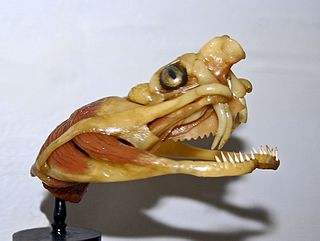
Snake venom is highly modified saliva containing zootoxins which facilitates the immobilization and digestion of prey, and defense against threats. It is injected by unique fangs after a bite, and some species are also able to spit their venom.
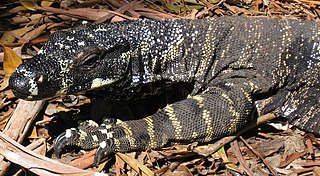
A goanna is any of several Australian monitor lizards of the genus Varanus, as well as certain species from Southeast Asia.

An animal bite is a wound, usually a puncture or laceration, caused by the teeth. An animal bite usually results in a break in the skin but also includes contusions from the excessive pressure on body tissue from the bite. The contusions can occur without a break in the skin. Bites can be provoked or unprovoked. Other bite attacks may be apparently unprovoked. Biting is a physical action not only describing an attack but it is a normal response in an animal as it eats, carries objects, softens and prepares food for its young, removes ectoparasites from its body surface, removes plant seeds attached to its fur or hair, scratching itself, and grooming other animals. Animal bites often result in serious infections and mortality. Animal bites not only include injuries from the teeth of reptiles, mammals, but fish, and amphibians. Arthropods can also bite and leave injuries.
Envenomation is the process by which venom is injected by the bite or sting of a venomous animal.

Sistrurus miliarius, commonly called the 'pygmy rattlesnake,' is a species of venomous snake in the subfamily Crotalinae of the family Viperidae. The species is endemic to the southeastern United States. Three subspecies are currently recognized including the nominate subspecies described here.

Micrurus tener is a species of venomous snake in the family Elapidae. The species is endemic to the southern United States and northeastern and central Mexico. There are four recognized subspecies; the nominotypical subspecies, Micrurus tener tener, which is found in both the US and Mexico, is commonly known as the Texas coral snake. This species was once considered to be a subspecies of the eastern coral snake.

Latrodectism is the illness caused by the bite of Latrodectus spiders. Pain, muscle rigidity, vomiting, and sweating are the symptoms of latrodectism. Contrary to popular conception, latrodectism is very rarely fatal for humans, though domestic cats have been known to die due to convulsions and paralysis.
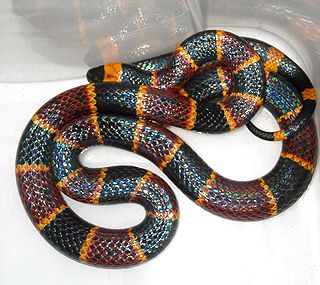
Micrurus fulvius, commonly known as the eastern coral snake, common coral snake, American cobra, and more, is a species of highly venomous coral snake in the family Elapidae. The species is endemic to the southeastern United States. It should not be confused with the scarlet snake or scarlet kingsnake, which are harmless mimics. No subspecies are currently recognized.
Snake antivenom is a medication made up of antibodies used to treat snake bites by venomous snakes. It is a type of antivenom.
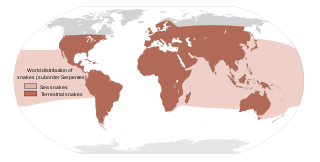
Most snakebites are caused by non-venomous snakes. Of the roughly 3,700 known species of snake found worldwide, only 15% are considered dangerous to humans. Snakes are found on every continent except Antarctica. There are two major families of venomous snakes, Elapidae and Viperidae. Three hundred twenty five species in 61 genera are recognized in the family Elapidae and 224 species in 22 genera are recognized in the family Viperidae, In addition, the most diverse and widely distributed snake family, the colubrids, has approximately 700 venomous species, but only five genera—boomslangs, twig snakes, keelback snakes, green snakes, and slender snakes—have caused human fatalities.

Animal attacks are a cause of human injuries and fatalities worldwide. Up to five million people in the U.S. are attacked by dogs each year. The frequency of animal attacks varies with geographical location. In the United States, a person is more likely to be killed by a domesticated dog than they are to die from being hit by lightning according to the National Safety Council.
